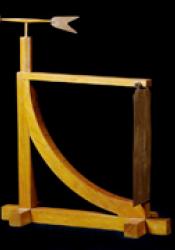Anemometer
The usage of simple instruments to indicate the direction of the wind has been known since before the Middle Ages. Leon Battista Alberti developed the anemometer in 1450 to measure wind velocity. However, Leonardo da Vinci redesigned the device, making it more accurate and easier to measure wind force. The anemometer functions because a piece of wood is attached to a frame and gets raised by the wind flowing across the contraption. A scale is labeled on the frame and based on the highest location achieved by the moving piece of wood, a relatively accurate measurement of wind force can be determined. Later versions of the anemometer included applications of fluid dynamics, where wind pressure resulted in a liquid column travelling up a tube and the distance traveled being related to wind force. Another style of anemometer by Thomas Robinson in 1845 included a revolving contraption that spun freely in the wind and wind velocity being able to be determined based on the number of revolutions per unit of time.
Sources:
“Anemometer.” Leonardo Da Vinci's Anemometer Invention, 2008, www.da-vinci-inventions.com/anemometer.aspx.
“Windvanes and Anemometers.” Multimedia Catalogue, 2010, https://brunelleschi.imss.fi.it/museum/esim.asp?c=500005.
Image Source : Permission to use by Fondazione Museo Nazionale della Scienza e della Tecnologia Leonardo da Vinci - via San Vittore, 21 - 20123 Milano (Italia). “Anemometer - Leonardo Da Vinci.” Museoscienza, 2018, www.museoscienza.org/english/leonardo/models/macchina-leo.asp?id_macchina=20.

